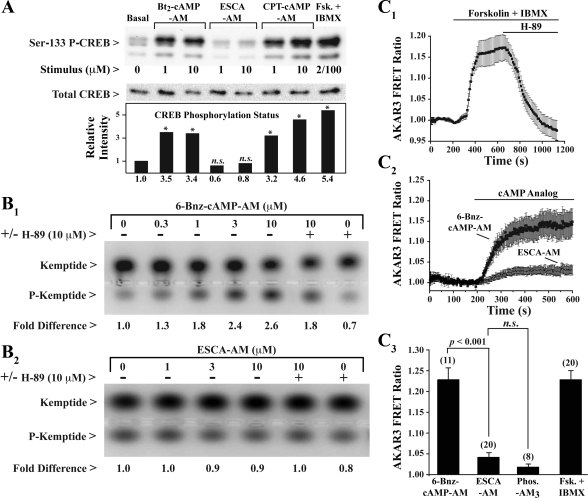Fig. 3.
8-pCPT-2′-O-Me-cAMP-AM fails to activate PKA. A: cAMP response element-binding protein (CREB) phosphorylation assay for human islets treated with Bt2-cAMP-AM, ESCA-AM, 8-CPT-cAMP-AM, forskolin (Fsk), and IBMX. Immunoblot analysis was performed to detect Ser133-phosphorylated CREB (P-CREB) or total CREB. The histogram is based on the average of 2 experiments using 2 islet preparations (*P < 0.05, t-test). B1 and B2: PKA activation assay for human islets treated with 6-Bnz-cAMP-AM or 8-pCPT-2′-O-Me-cAMP-AM. Electrophoresis was performed to resolve phosphorylated (P-Kemptide) and nonphosphorylated (Kemptide) forms of PepTag. C1–C3: AKAR3 assay for PKA activation in human β-cells. C1: AKAR3 exhibited an increase of fluorescence resonance energy transfer (FRET) emission ratio in response to forskolin (2 μM) and IBMX (100 μM), and this increase was reversed by H-89 (10 μM). C2: an increase of FRET emission ratio was also measured in response to 6-Bnz-cAMP-AM (10 μM) but not 8-pCPT-2′-O-Me-cAMP-AM (10 μM). C3: single-cell population study of AKAR3 responsiveness to cAMP analogs, Phos-AM3, or forskolin with IBMX using concentrations of test substances indicated for C1 and C2. Numbers above each histogram bar indicate the number of cells imaged. Statistical significance was evaluated using the t-test. n.s., Not significant. Findings are representative of results obtained in 2 experiments using islets obtained from 2 donors.

